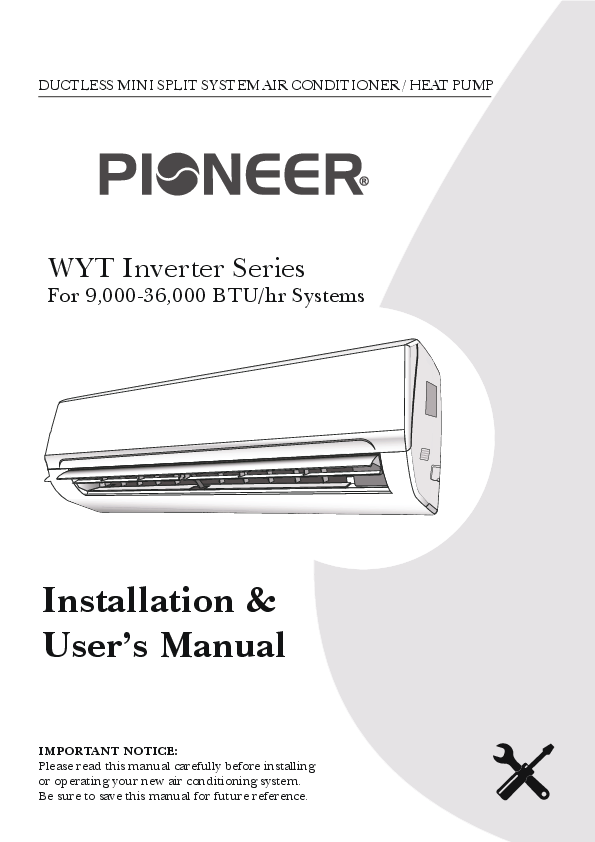 |
Pioneer WYT-24 Inverter Series Installation and User's Manual
Comprehensive guide for installing, operating, and maintaining Pioneer WYT-24 Inverter Series ductless mini-split air conditioners and heat pumps (9,000-24,000 BTU/hr, Quantum Ultra R-454B). Includes safety, system components, installation steps, operation modes, troubleshooting, and refrigerant handling. |
 |
Pioneer WYT-20 Inverter Series Installation and User's Manual
Comprehensive installation and user's manual for the Pioneer WYT-20 Inverter Series Diamante Pro ductless mini-split air conditioning and heat pump systems. Covers safety precautions, system components, operating instructions, maintenance, installation, troubleshooting, and more. |
 |
Pioneer WYT-22 Inverter Series: Installation & User's Manual for Air Conditioner/Heat Pump
Comprehensive installation and user's manual for the Pioneer WYT-22 Inverter Series ductless mini-split air conditioner and heat pump systems (9,000-24,000 BTU/hr). Covers safety, installation, operation, maintenance, and troubleshooting. |
 |
Pioneer WYF-25 Inverter Series Installation and User's Manual
Comprehensive guide for installing and operating the Pioneer WYF-25 Inverter Series ductless mini-split air conditioner and heat pump systems, covering safety precautions, system components, operating instructions, and troubleshooting. |
 |
Pioneer WT012ALUI17HLD/YN012ALUI17RPD Ductless Mini-Split Heat Pump Specifications
Detailed submittal sheet and specifications for the Pioneer WT012ALUI17HLD/YN012ALUI17RPD 17 SEER2 wall-mounted ductless inverter heat pump system, including performance data, dimensions, electrical requirements, features, and available accessories. |
 |
Pioneer YN-L Multi-Zone Series Ductless Mini Split Installation Guide - A2L Refrigerant Addendum
Comprehensive installation guide addendum for Pioneer YN-L Multi-Zone Series ductless mini-split air conditioner and heat pump systems. Covers A2L refrigerant safety, installation procedures, wiring, piping, evacuation, and disposal for 2, 3, 4, and 5-zone configurations. |
 |
Pioneer WYT-FA25 Inverter Series Parts Diagram - Air Conditioner & Heat Pump Components
Explore the comprehensive parts diagram for the Pioneer WYT-FA25 Inverter Series ductless mini-split air conditioner and heat pump. This guide details indoor and outdoor unit components, essential for maintenance and identification. |
 |
Pioneer Diamante Pro Ductless Wall Mount Split Systems - High Efficiency Heat Pumps
Explore the Pioneer Diamante Pro Ductless Wall Mount Split Systems, offering high efficiency with SEER ratings up to 23 and HSPF ratings up to 10.0. These systems feature DC inverter technology, low noise operation, and eco-friendly R454b refrigerant, suitable for various room sizes and low ambient temperatures. |








